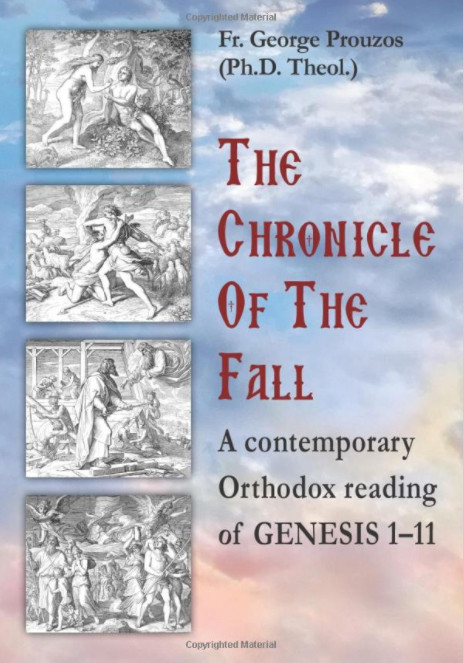THE CHRONICLE OF THE FALL
by
Fr.
George Prouzos
A new book by
Fr. George Prouzos, Doctor of Theology of the Aristotelian
University of Thessaloniki has been released, titled "The Chronicle
of the Fall".
This
book is an in-depth study of the stages of man’s fall from the
original blessed glory which adorned him at his creation. It has
taken the form of a Commentary on GENESIS
1-11, exclusively from the
SEPTUAGINT
text, and is
richly adorned with comments and thoughts from the illuminated pen
of the holy Fathers of the Church.
The mindset governing its compilation is
based on the belief that any interpretive approach to the divine
Scriptures must help the reader to know better, to understand more
deeply, and ultimately to love the benevolent God “with all his
heart, with all his soul, and with all his mind.”
At the same time, through the submission of new interpretive
suggestions regarding many still undefined biblical issues, it aims
at the dynamic expansion of the hermeneutic experience, assisting
contemporary Orthodox Theology to respond to the growing interest of
our brethren both in and outside of our holy Church.
These interpretive suggestions include:
-
Τhe interpretation of Gen. 1: 2-8. Compatibility of Septuagint with
contemporary cosmology.
-
The incorruptibility of plants and animals created within
Hexaemeron.
-
The singular and plural versions of the divine image on man.
-
The interpretation of the divine likeness of man.
-
The scope of man’s “dominion over all the earth”; its connection
with the completed work of Christ, and the possibility of life in
other worlds.
-
The soil of the Third Day of Hexaemeron, as the component of Adam’s
body.
-
Man is perfect and also praying from his conception.
-
The placement of the devil’s fall after Hexaemeron.
-
The decay and death brought to creation by the fall of the devil,
before the planting of Paradise and the Fall of man.
-
The extraordinary divine creative energy of planting Paradise, as a
bulwark against the decay and death that prevailed in the rest of
the earth.
-
The re-creation of plants and animals in Paradise with their
original incorruptibility.
-
The interpretation of the two trees “in the midst of the Paradise.”
-
The interpretation of the anonymity of the great river of Paradise
in contrast to its named tributaries.
-
The interpretation of the divine command to Adam to “work and guard”
the Paradise.
-
The interpretation of ecclesiastical dating “from the creation of
the world.”
-
The course to the Fall.
-
The role of the serpent.
-
The interpretation of the presence of the devil in Paradise and his
dialogue with the woman.
-
The interpretation of the tunics of skin and of eating from the tree
of life after the Fall.
-
The interpretation of the sacrifices of Cain and Abel. Their
connection with the two kinds of Priesthood. Melchizedek and St.
Simeon the God-receiver.
-
God’s dialogue with Cain after the fratricide. The potential killers
of Cain. The inhabitants of the city of Enoch.
-
The interpretation of Noema’s mention among Cain’s descendants.
-
The interpretation of common names in the genealogies of Cain and
Seth.
-
The interpretation of Mathusala’s longevity.
-
The interpretation of the “120 years” of Gen. 6: 3.
-
The interpretation of Noe’s drunkenness.
-
Why Noe had no further procreation.
-
The interpretation of verses 9: 22-27. The eschatological
restoration of the fraternal unity of Sem, Cham and Japheth within
the Church.
-
The interpretation of tower building and the confusion of languages.
-
The interpretation of the longevity of Sem and his descendants.
Visit the detailed Index of Contents

***********************
Other books (in Greek) published by the same
author:
http://www.aixminews.gr/index.php/2021/11/25/kikloforisan-tessera-nea-vivlia-tou-p-gevrgiou-prouzou/
Original post: 27-11-2021
|

